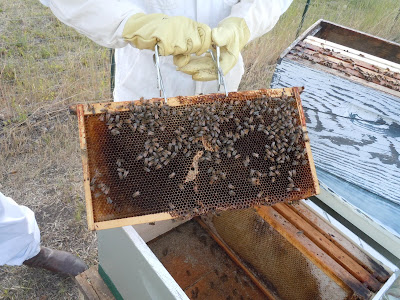
We've now headed down the road of amateur Bee Keeping. As you know, this summer a swarm of honey bees invaded our house and set up shop in our ceiling. I built a bee vac and removed the bees, with the hope of establishing them in a hive. Despite my very clumsy handling of the bees, they accepted the new hive and have continued to thrive.

A few days after our first colony capturing adventure, we got a call about a honey bee swarm near a friend's house. Apparently we were now considered experienced in capturing bees (news travels fast in a small town). So after a little debate, we were headed out to capture a swarm for the second time. This swarm was on a fence post so there was no need for the bee vac. All we had to do was get the majority of the swarm in a box (queen included) and then wait for the workers to find her. It actually worked, and that night we were headed home with a bee swarm in a box. The only trouble was that we had no more hives, so Whitney ran over to the nearest bee supply place an hour away and got us outfitted with everything we needed for our new bee keeping endeavour.

As luck would have it, we had an experienced bee keeper coming to visit us. My Dad has been keeping bees for many years on his farm, and was more than happy to help us get started. Dad helped us put together our new hive boxes and was full of good advice about bees.

We got the new swarm established and with Dad's help have been able to keep them happy.

In this photo (above) my Dad shows Whitney how to move frames into a new hive box and inspect the frames.
While he was here, Dad showed us how to check the bees and tell the difference from brood comb and honey comb. He also helped us figure out what equipment and supplies we needed, and put together a plan to help the bees survive the winter. We even got to see one of our queens while he was were, a real thrill to new bee keepers.

As of this post, we have two hives with healthy colonies busily building brood and storing honey for the coming winter. Our plan will be to help them get strong this year, and hope for honey about a year from now.

Dad and I standing by our two busy hives enjoying the evening.
KJ



 We're also getting very nice tomatoes, carrots, cucumbers, beets and zucc's. The harvest season is upon us!
We're also getting very nice tomatoes, carrots, cucumbers, beets and zucc's. The harvest season is upon us! 













